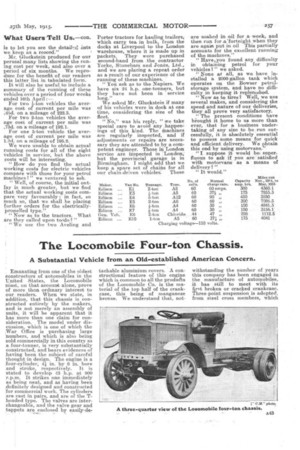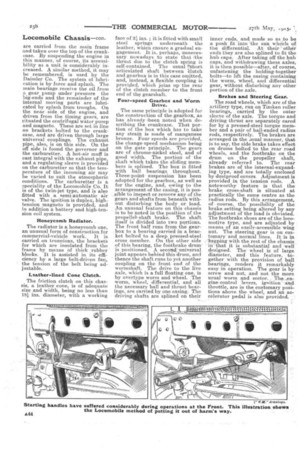The Locomobile Four-ton Chassis.
Page 13

Page 14

If you've noticed an error in this article please click here to report it so we can fix it.
A Substantial Vehicle from an Old-established American Concern.
. Emanating from one of the oldest constructors of automobiles in the United States, the Loeomobile must, on that account alone, prove of more than ordinary interest to our readers. When we state, in addition, that this chassis is constructed entirely by the makers, and is not merely an assembly of units, it will be apparent that it has more than one claim for consideration. The model under discussion, which is one of which the .War Office is purchasing large numbers, and which is also being sold commercially in this country as a four-tormer, is very substantially constructed, and bears evidences of having been the subject of careful thought in design. The engine is a four-cylinder, 41in. by 6 in. bore and stroke, respectively. it is stated to develop 43 h.p. at 900 r.p.m. It strikes one immediately as being neat, and as having been definitely designed and constructed for commercial work. The cylinders are cast in pairs, and are of the Theaded type. The valves are interchangeable, -and -and the valve gear and tappets are enclosed by easily-de tachable aluminium covers. A constructional feature of this engine which is common to all the produets of the Locornobile Co. is the material of the top half of the crankcase, this being of manganeze br,onze. We understand that, not withstanding the number of years this company has been engaged in. the manufacture of automobiles, it has still to meet with its first broken or cracked crankcase. Three-point suspension is adopted, from steel cross members, which
are carried from the main frame and taken over the top of the crankcase. By suspending the engine in this manner, of course, its accessibility as a unit is considerably increased. A similar method, it may he remembered, is used by the Daimler Co. The system of lubrication is by force and splash. The main bearings receive the oil from a gear punip under pressure the big-ends and the remainder of the internal moving parts are lubricated by splash from troughs. On the near . side of the engine, and driven from the timing gears, are situated the centrifugal water pump and magneto. These are set in line on brackets bolted to the crankcase, and are driven through large universal couplings. The exhaust pipe, also, is on this side. On the off side is found the governor and the carburetter. A hot-air muff is cast integral with the exhaust pipe, and a regulating sleeve is provided on the carburetter so that the temperature of the incoming air may be varied to suit the atmospheric conditions. The carburetter is a speciality of the Locomobile Co. It is of the twin-jet type, and is also fitted with a semi-automatic air valve. The ignition is duplex, hightension magneto is provided, and in addition a battery and high-tension coil system.
Honeycomb Radiator.
The radiator is a honeycomb one, an unusual form of construction for commercial-vehicle work. It is carried on trunnions, the brackets for which are insulated from the frame by means of thick rubber blocks. It is assisted in its efficiency by a large belt-driven fan, the tension of the belt being adjustable.
Leather-lined Cone Clutch.
The friction clutch on this chassis, a leather cone, is of adequate size and width, being no less than 18?-1 ins. diameter, with a working face of 2?, ins. ; it is fitted with small steel springs underneath the leather, which ensure a gradual engagement. It is, perhaps, unnecessary nowadays to state that the thrust due to the clutch spring is self-contained. The usual l';'Short articulated shaft between 'dutch and gearbox is in this case omitted, and, instead, a flexible coupling is provided, which joins up the rear of the clutch member to the front end of the gearshaft, Four-speed Gearbox and Worm Drive.
• The same principle is adopted for the construction of the gearbox, as has already been noted when describing the crankcase. That portion of the box which has to take any strain is made of manganese bronze. Four speeds are provided, the change-speed mechanism being on the gate principle. The gears are of chrome-nickel steel, and of good width. The portion of the shaft which takes the sliding members is splined. The box is fitted with ball bearings throughout. Three-pointsuspension has been adopted for the gearbox, ai well as for the engine, and, owing to the arrangement of the casing, it is possible to inspect or remove any of the gears and shafts from beneath without disturbing the body or load. An unusual feature on this chassis is to be noted in the position of the propellet-shaft brake. The shaft itself is divided into two portions. The front half runs from the gearbox to a bearing carried in a bracket bolted to a deep pressed-steel crass member. On the other side of this bearing, the fo6tbrake drum is positioned. A secona universal joint appears behind this drum, and thence the shaft runs to yet another coupling on the front end of the wormshaft. The drive to the live axle, Which is a full floating one, is by overtype worm and wheel. The worm, wheel, differential, and all the necessary ball and thrust bearings, are carried by one casing. The driving shafts are splined on their inner ends, and, made so as Jai. be a push fit into the sun wheels of the differential. At their other ends they are also splined to fit the hub caps. After taking off the hub -caps, and withdrawing these axles, it is then possible—after, of course, unfastening the holding-together bolts--to lift the easing containing the worm, wheel, and differential gear, without disturbing any other portion of the axle.
Brakes and Steering Gear.
The road wheels, which are of the artillery type, run on Timken roller bearings, carried by the outer sleeve of the axle. The torque and driving thrust are separately cared for by a pressed-steel torque member and a pair of ball-ended radius rods, respectively. The brakes are arranged in the asual manner, that is to say, the side brake takes effect on drums bolted to the rear road wheels, and the footbrake on the drum on the propeller shaft, already referred to. The rear brakes are of the internal-expanding type, and are totally enclosed by dustproof covers. Adjustment is provided in the tension rods. A noteworthy feature is that the brake cross-shaft is situated at practically the same centre as the radius rods. By this arrangement, course, the possibility of the brake setting being altered by any adjustment of the load is obviated. The footbrake shoes are of the locomotive type, and are adjusted by means of an easily-accessible wing nut. The steering gear is on customary and normal lines. It is in keeping with the rest of the chassis in that it is substantial and well designed. The wheel is of large diameter, and this feature, together with the provision of ball bearings, renders it remarkably easy in operation. The gear is by screw and nut, and not the more usual worm and sector. The ,engine-control levers, ignition atid throttle, are in the customary positions above the wheel, and an accelerator pedal is also provided.




















